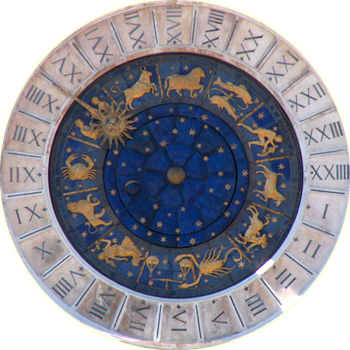
Classical planet
A classical planet is an astronomical object that is visible to the naked eye and moves across the sky and its backdrop of fixed stars (the common stars which seem still in contrast to the planets). Visible to humans on Earth there are seven classical planets (the seven luminaries). They are from brightest to dimmest: the Sun, the Moon, Venus, Jupiter, Mars, Mercury and Saturn.
"Wandering stars" redirects here. For other uses, see Wandering star. For the failed IAU planet category of Classical Planets, see IAU definition of planet.
Greek astronomers such as Geminus[1] and Ptolemy[2] recorded these classical planets during classical antiquity, introducing the term planet, which means 'wanderer' in Greek (πλάνης planēs and πλανήτης planētēs), expressing the fact that these objects move across the celestial sphere relative to the fixed stars.[3][4] Therefore, the Greeks were the first to develop the astrological connections to the planets' visual detail.[5]
Through the use of telescopes other celestial objects like the classical planets were found, starting with the Galilean moons in 1610. Today the term planet is used considerably differently, with a planet being defined as a natural satellite directly orbiting the Sun (or other stars) and having cleared its own orbit. Therefore, only five of the seven classical planets remain recognized as planets, alongside Earth, Uranus, and Neptune.
In alchemy, each classical planet (Moon, Mercury, Venus, Sun, Mars, Jupiter, and Saturn) was associated with one of the seven metals known to the classical world (silver, mercury/quicksilver, copper, gold, iron, tin and lead respectively). As a result, the alchemical glyphs for the metal and associated planet coincide. Alchemists believed the other elemental metals were variants of these seven (e.g. zinc was known as "Indian tin" or "mock silver"[18]).
Alchemy in the Western World and other locations where it was widely practiced was (and in many cases still is) allied and intertwined with traditional Babylonian-Greek style astrology; in numerous ways they were built to complement each other in the search for hidden knowledge (knowledge that is not common i.e. the occult). Astrology has used the concept of classical elements from antiquity up until the present day today. Most modern astrologers use the four classical elements extensively, and indeed they are still viewed as a critical part of interpreting the astrological chart.
Traditionally, each of the seven "planets" in the Solar System as known to the ancients was associated with, held dominion over, and "ruled" a certain metal (see also astrology and the classical elements).
The list of rulership is as follows:
Some alchemists (e.g. Paracelsus) adopted the Hermetic Qabalah assignment between the vital organs and the planets as follows:[18]
Naked-eye planets[edit]
Mercury and Venus are visible only in twilight hours because their orbits are interior to that of Earth. Venus is the third-brightest object in the sky and the most prominent planet. Mercury is more difficult to see due to its proximity to the Sun. Lengthy twilight and an extremely low angle at maximum elongations make optical filters necessary to see Mercury from extreme polar locations.[23] Mars is at its brightest when it is in opposition, which occurs approximately every twenty-five months. Jupiter and Saturn are the largest of the five planets, but are farther from the Sun, and therefore receive less sunlight. Nonetheless, Jupiter is often the next brightest object in the sky after Venus. Saturn's luminosity is often enhanced by its rings, which reflect light to varying degrees, depending on their inclination to the ecliptic; however, the rings themselves are not visible to the naked eye from the Earth.